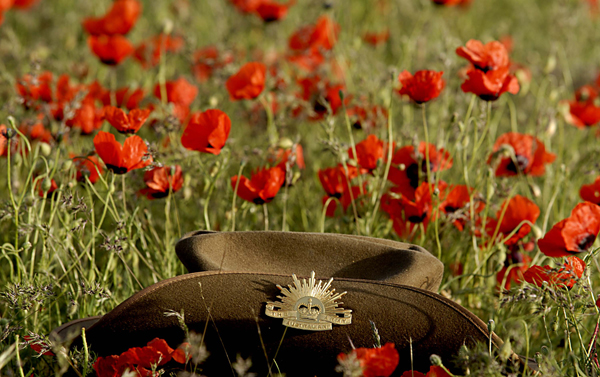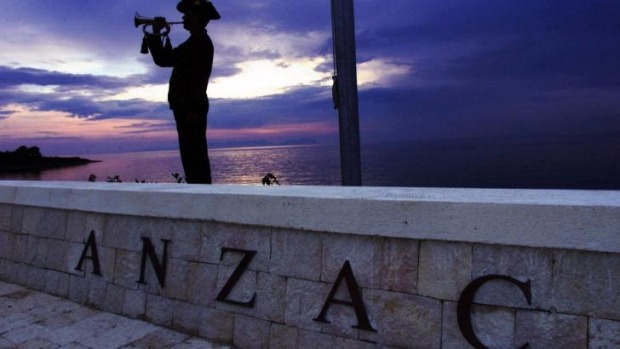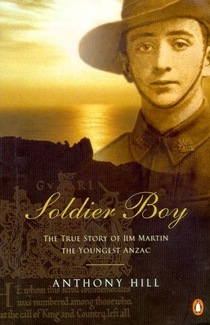This WebQuest was created by Melissa Creswell, pre-service teacher at the University of Wollongong.
Introduction

The term ANZAC stands for Australian and New Zealand Army Corps. The soldiers within those forces are better known as Anzacs.
On the 25th of April 1915 the Anzacs landed on the Gallipoli peninsula and took part in the First World War. Australia alone lost over 8,000 soldiers in this war. There were thousands of casualties and each side experienced hardships.
The 25th of April each year marks the anniversary of this event. This day is known as ANZAC day. Commemoration events are held across Australia to remember and pay respect to the servicemen and servicewomen who died in the First World War. The commemoration services take place at dawn, which was the time of the original landing in Gallipoli.
Task

The tasks that you will need to complete involve writing and creating.
You will get to create a PowerPoint, write an information report, and you will also get to do some creative writing in the form of letters and diary entries.
By completing these tasks you will have the opportunity to view historical documents and research information that relates to a few aspects of ANZAC history.
I hope this WebQuest will allow you to develop a lifelong interest in and enthusiasm for history.
Process
TASK 1:
Familiarise yourself with the history of ANZAC day. The purpose of task one is for you to become familiar with some factual ANZAC history. Create a PowerPoint and answer the following questions. Make sure you only have one question and answer per slide. Include pictures or videos that relate to the topic.
Questions:
What does the term ANZAC stand for?
When is ANZAC day held?
What happens on ANZAC day?
Why is ANZAC day so important to Australians?
Here are some links that will help you to find the answers to the questions:
https://www.awm.gov.au/commemoration/anzac-day/
http://www.army.gov.au/Our-history/Traditions/Anzac-Day
TASK 2:
The Last Post is a well-known symbol that relates to the history of ANZAC. Watch the Australian Army video clip of the Last Post on YouTube, then add to your PowerPoint slide the answer to the following question:
Question:
What is the Last Post and what is its significance?
Here is the link to the Last Post YouTube clip:
Here are some other links that will help you to find the answer to the question:
https://www.awm.gov.au/commemoration/customs/last-post/
http://www.bbc.com/news/magazine-34768398
http://www.army.gov.au/Our-history/Traditions/The-Last-Post
For this task it would be appropriate to add the link to the YouTube in your PowerPoint. This can be done as one slide and the answer to the question can go on another slide.
TASK 3:

Private James Charles (Jim) Martin was only 14 years and 3 months old when he enlisted into the Army. He lied about his age and told the recruitment officers that he was 18. This task involves you doing some research on him and producing a typed Word document report.
In the report make sure you include the following information and also add anything else that you find relevant:
Include:
- Name
- Date of Birth and place of birth
- Date of Death and place of death
- Where did he live in Australia?
- What role did he have in World War 1?
- How did he die?
- What unit was he in?
- What was his service number?
- What was his final rank?
- Why did he enlist in the war?
- Did he receive any medals?
- Add any other information that interests you and explain why it is interesting.
Here are some links to help you answer the question:
https://www.awm.gov.au/encyclopedia/martin/
https://www.awm.gov.au/people/P10676585/#biography
http://www.army.gov.au/Our-history/History-in-Focus/The-Youngest-ANZAC
http://vrroom.naa.gov.au/print/?ID=25318
http://www.gallipoli.gov.au/explore-northern-war-cemeteries/lone-pine-cemetery.php
TASK 4:
Find diary entries and letters written in relation to Private James Charles Martin. For this task you will need to use information that you find and pretend that you are Private James Charles Martin. For this task you only need to complete one of the following. It is up to you to choose the one you would like to complete.
Option 1:
Your task is to write a letter back home. Explain how you were feeling and what you can hear, smell etc. What food did you eat? What was happening? Ask your mum and dad questions.
Option 2:
Write a diary entry pretending to be Private James Charles Martin on the day that he died. Explain how you feel, what is happening around you, what has already happened.
Option 3:
You are Private James Charles Martin’s mother. Write a letter to your son and explain what is happening back at home. For this task you may need to do a little bit more research by finding out who his mum is and find out what was happening in Australia at the time.
These are some useful links for you to complete this task. Remember you can extend on these and do some additional research on your own:
https://www.awm.gov.au/collection/RCDIG0000970/
https://www.awm.gov.au/collection/PR85/382/
https://www.awm.gov.au/people/P10676585/#collection-items
https://www.awm.gov.au/collection/RCDIG0001457/
Extension Activities:
1. Watch the Last Post ceremony that commemorates Private James Charles Martin.
You can find the video here: https://www.awm.gov.au/collection/PAFU2015/435.01/

2. Read the book Soldier Boy by Anthony Hill. This book is a true story based on Private James Charles Martin.
You can find out more information about the book here:
http://www.anthonyhillbooks.com/soldierboymain.html
The above link has extra questions and activites that you might like to complete in your own time, or if you finish all the other tasks. These other activities can be found in the Teaching notes section.
3. Explore the ABC 3D documentary site. It has some great information about the Gallipoli campaign and is a fantastic interactive resource.
Here is the link:
http://www.abc.net.au/innovation/gallipoli/gallipoli2.htm
4. There is a fantastic lesson available through the Centenary education website that encourages students to do some research on a local person who served in the First World War. It involves students practising their letter-writing skills by writing to another student in their class and telling them things they learned about the serviceman or servicewoman that they researched.
For more information about this click on this link:
http://www.centenaryeducation.com.au/letterwriting.php
Evaluation
Student Self-Evaluation
How do you think you went completing the tasks? Here is your chance to complete a self-evaluation on your success. In a Word document copy and complete the following information.
| How do you rate: | Excellent | Good | Poor |
| Your time management while completing tasks? | |||
| Your ability to work independently? | |||
| Your ability to follow the directions set out in the tasks? | |||
| Your ability to write informatively? | |||
| Your ability to write creatively? | |||
| Your effort? |
Complete the following sentences:
While completing the tasks I learned the following things...
The things I found most interesting were...
The things I didn't find interesting were...
What I felt I did well in was...
What I felt I could have done better in was...
Do you have any other comments about the task?
Conclusion

Congratulations! You have now completed your WebQuest and have learned a whole heap of information about the history of ANZAC.
By completing the WebQuest you have expanded your knowledge and understanding of historical concepts and have undertaken a process of historical inquiry. Go home and tell your family about all the new information you have learned.
I hope you enjoyed completing the tasks and have developed a lifelong interest for history.
Credits
Reference List:
Anthony Hill Books (2012). Soldier Boy: The True Story of Jim Martin the Youngest Anzac. Retrieved May 21, 2016, from http://www.anthonyhillbooks.com/soldierboymain.html
Australian Army (2014). The Last Post. Retrieved May 21, 2016, from http://www.army.gov.au/Our-history/Traditions/The-Last-Post
Australian Army (2015). Anzac Day. Retrieved May 21, 2016, from http://www.army.gov.au/Our-history/Traditions/Anzac-Day
Australian Army (2016). The Youngest ANZAC. Retrieved May 21, 2016, from http://www.army.gov.au/Our-history/History-in-Focus/The-Youngest-ANZAC
Australian Broadcasting Corporation (2016). Gallipoli: The First Day. Retrieved May 21, 2016, from http://www.abc.net.au/innovation/gallipoli/gallipoli2.htm
Australian War Memorial (2015). The Last Post Ceremony commemorating the service of (1553) Private James Charles Martin, 21st Battalion, AIF, First World War. Retrieved May 21, 2016, from https://www.awm.gov.au/collection/PAFU2015/435.01/
Australian War Memorial (2016). Anzac Day. Retrieved May 21, 2016, from https://www.awm.gov.au/commemoration/anzac-day/
Australian War Memorial (2016). James Charles (Jim) Martin (1901-1915). Retrieved May 21, 2016, from https://www.awm.gov.au/encyclopedia/martin/
Australian War Memorial (2016). Letters and certificates relating to James Charles Martin, 1915. Retrieved May 21, 2016, from https://www.awm.gov.au/collection/RCDIG0000970/
Australian War Memorial (2016). Martin, James Charles (Private, b. 1901 – d.1915). Retrieved May 21, 2016, from https://www.awm.gov.au/collection/PR85/382/
Australian War Memorial (2016). Newspaper cuttings relating to James Charles Martin 1915-1916. Retrieved May 21, 2016, from https://www.awm.gov.au/collection/RCDIG0001457/
Australian War Memorial (2016). Private James Charles Martin. Retrieved May 21, 2016, from https://www.awm.gov.au/people/P10676585/#biography
Australian War Memorial (2016). Private James Charles Martin. Retrieved May 21, 2016, from https://www.awm.gov.au/people/P10676585/#collection-items
Australian War Memorial (2016). The Last Post. Retrieved May 21, 2016, from https://www.awm.gov.au/commemoration/customs/last-post/
AustralianArmyHQ. (2012, April 9). The Last Post . Retrieved from https://youtu.be/G-Pz5KsyfN0
BBC News (2015). The story of the Last Post. Retrieved May 21, 2016, from http://www.bbc.com/news/magazine-34768398
Centenary Education (2014). Letter Writing. Retrieved May 21, 2016, from http://www.centenaryeducation.com.au/letterwriting.php
Commonwealth War Graves Commission (2015). Explore 25 northern war cemeteries: Lone Pine Cemetery and Memorial. Retrieved May 21, 2016, from http://www.gallipoli.gov.au/explore-northern-war-cemeteries/lone-pine-c…
Hill, A. (2001). Soldier boy: the true story of Jim Martin the youngest Anzac. Ringwood, Vic: Penguin.
National Archives of Australia (2010). Death of 14-year-old Private James Martin: Letter to Amelia Martin. Retrieved May 21, 2016, from http://vrroom.naa.gov.au/print/?ID=25318
The Australian (2013). He was only 14: youngest life lost. Retrieved May 21, 2016, from http://www.theaustralian.com.au/in-depth/anzac-day/he-was-only-14-young…